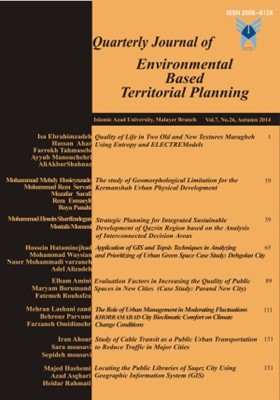Evaluation Factors in Increasing the Quality of Public Spaces in New Cities (Case Study: Parand New City)
Subject Areas :Elham Amini 1 , Maryam Borumand 2 * , Fatemeh Rouhafza 3
1 - PhD, Urban Planning, Urban Planning Department, Pardis Branch, Islamic Azad University, Tehran, Iran
2 - PhD, student, Urban Planning, Group of Urban Planning, Department of Art, Architecture and Urban Planning, Najafabad Branch, Islamic Azad University, Isfahan, Iran
3 - M.A. Urban Planning
Keywords: Social interactions, Urban Spaces, Environmental quality, New Cities,
Abstract :
In recent century, the urban population exceeded the rural population for the first time in the history. The increase of the urban population has forced the planners and policy-makers to develop the cities and establish new cities for the settlement of population overflow of the metropolises. The consequences of such a rapid growth on the one hand, and the results of the researches that show the dissatisfaction of the citizens with the policies of the urban development on the other hand, have made the urban managers and policy-makers look for the solution of the problems that are imposed by the development of the cities and establishing new cities worldwide. Meanwhile, the urban public spaces are critically important because they are accessed by all citizens and are regarded as the context of the social actions. An overview on the Iranian new cities shows the failure of the authorities in creating qualitatively desirable spaces. Indeed such cities have only formed for settling the overflow of the population of metropolises without paying attention to the urban qualified public spaces, and thus they have considerable effects on the mental and physical health of the citizens. Focusing on the concept of environmental quality and its effective components, this paper attempts to find the effective factors on the increase of the quality of public spaces in new cities. Considering the nature of the data, we have used descriptive and correlational research. The results of studying Parand New City of Iran shows that, there is a significant relationship between the level of accessibility to the space, personal characteristics of the citizens, and the increase of the quality of urban public spaces in the new cities.

